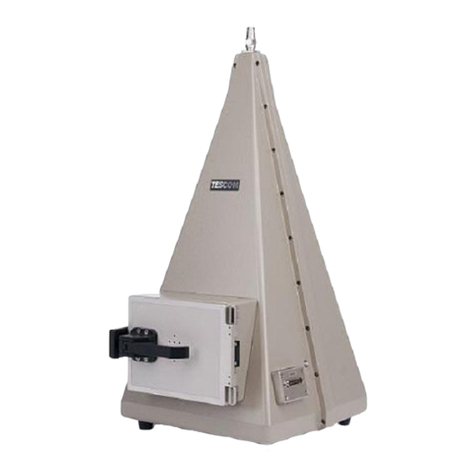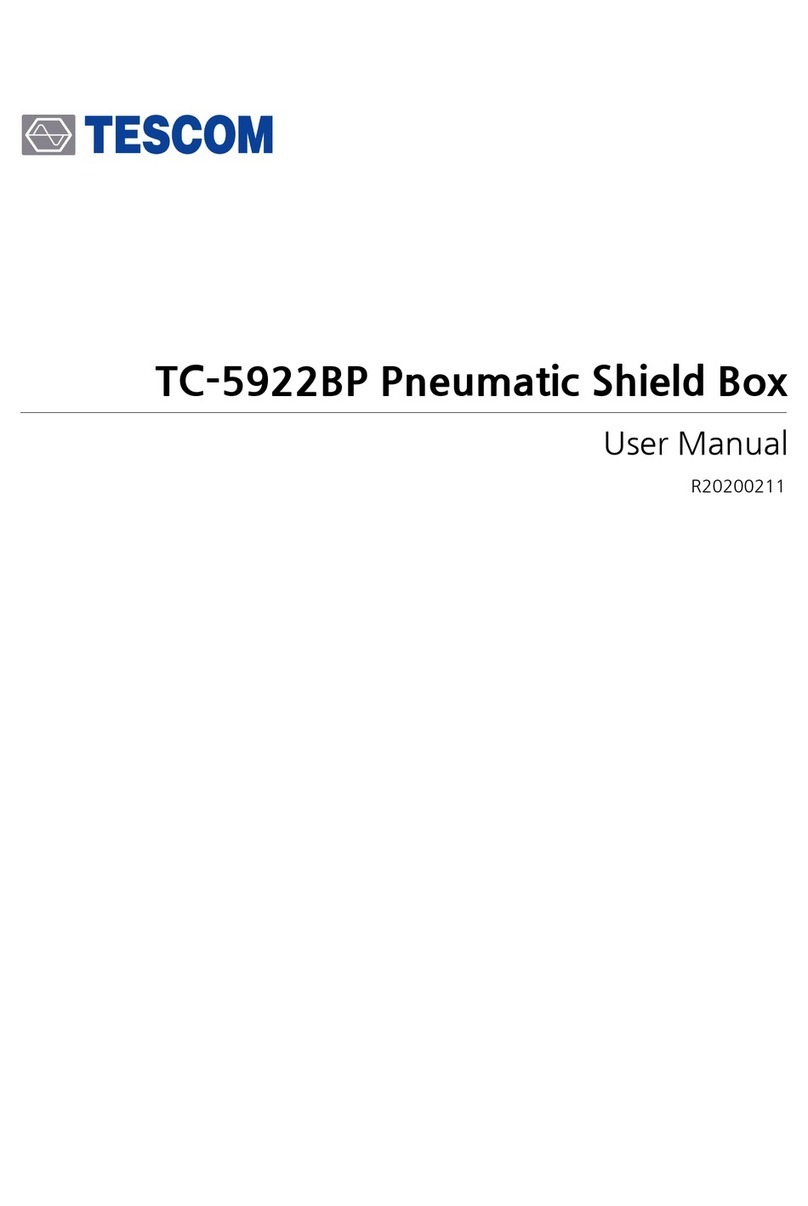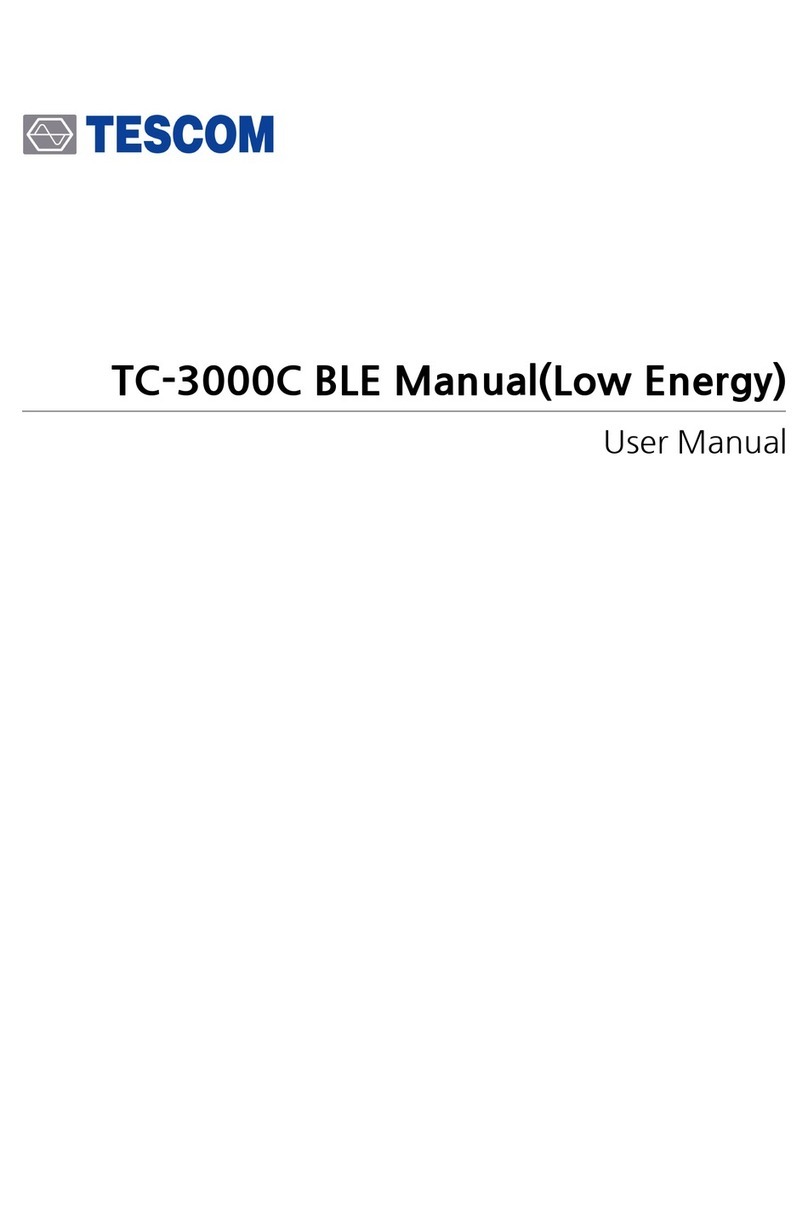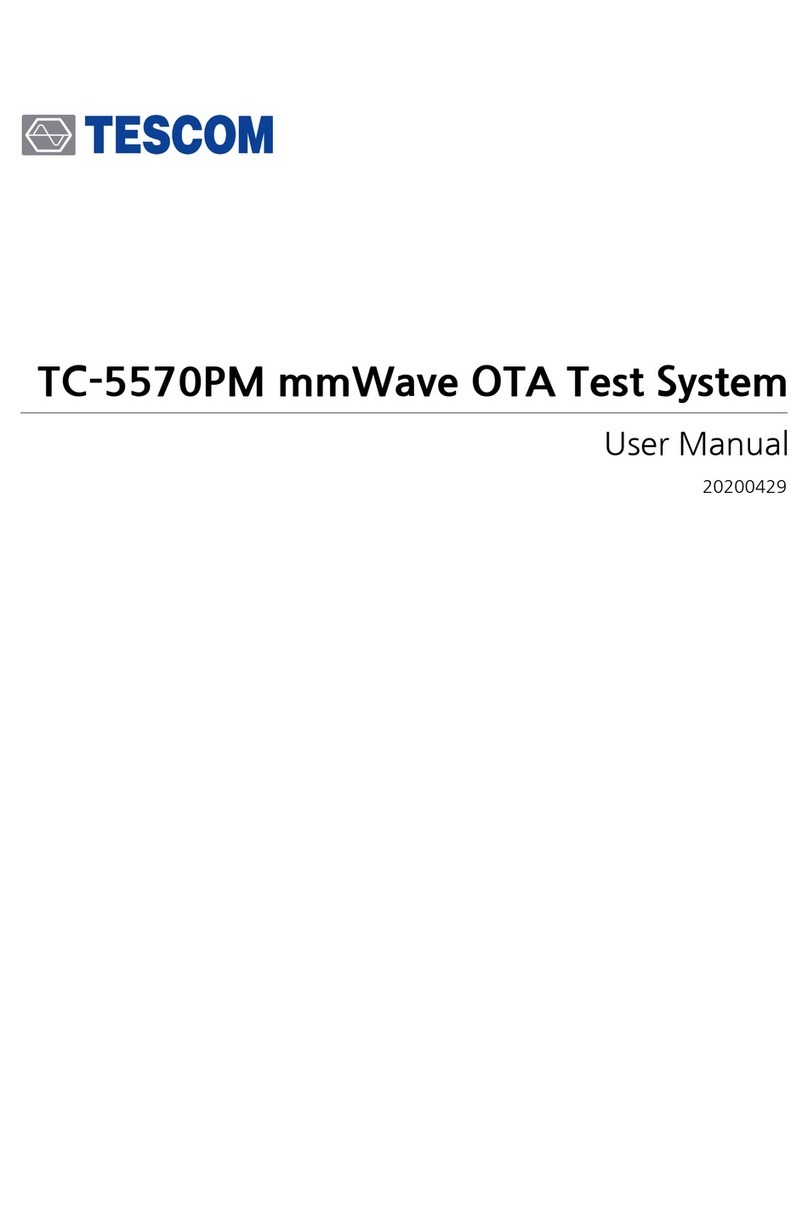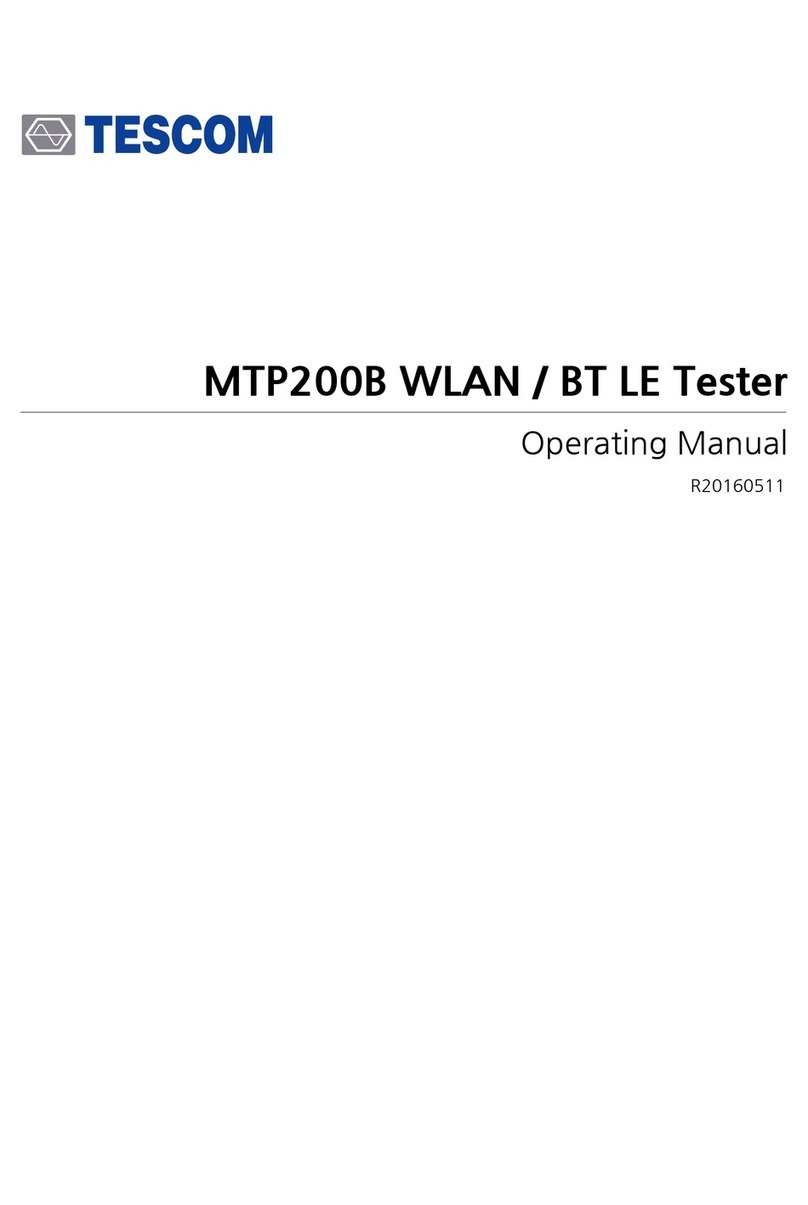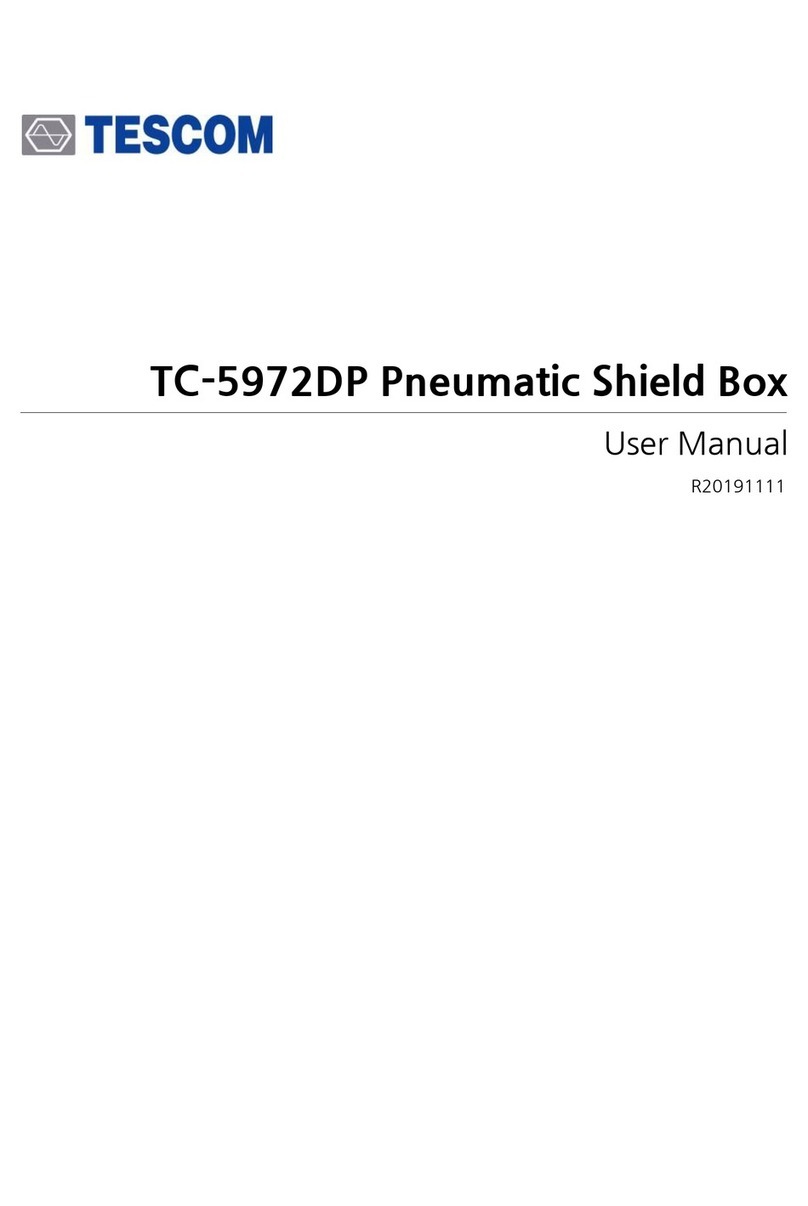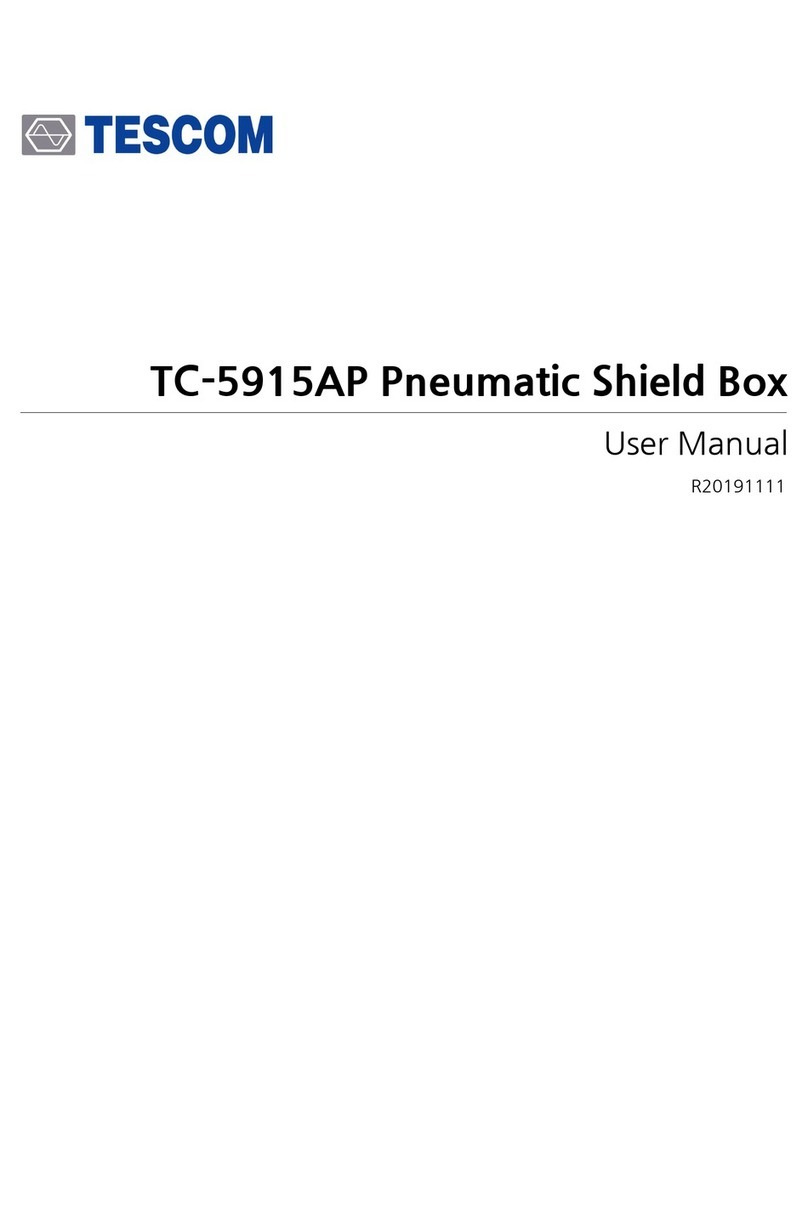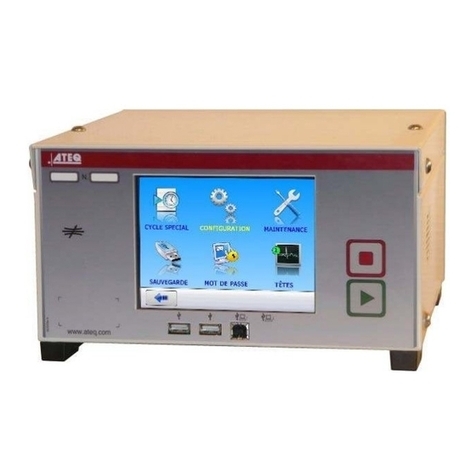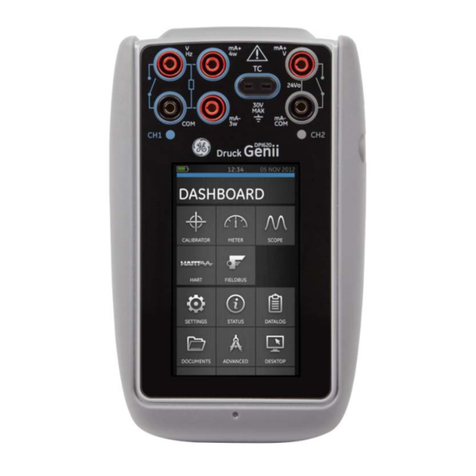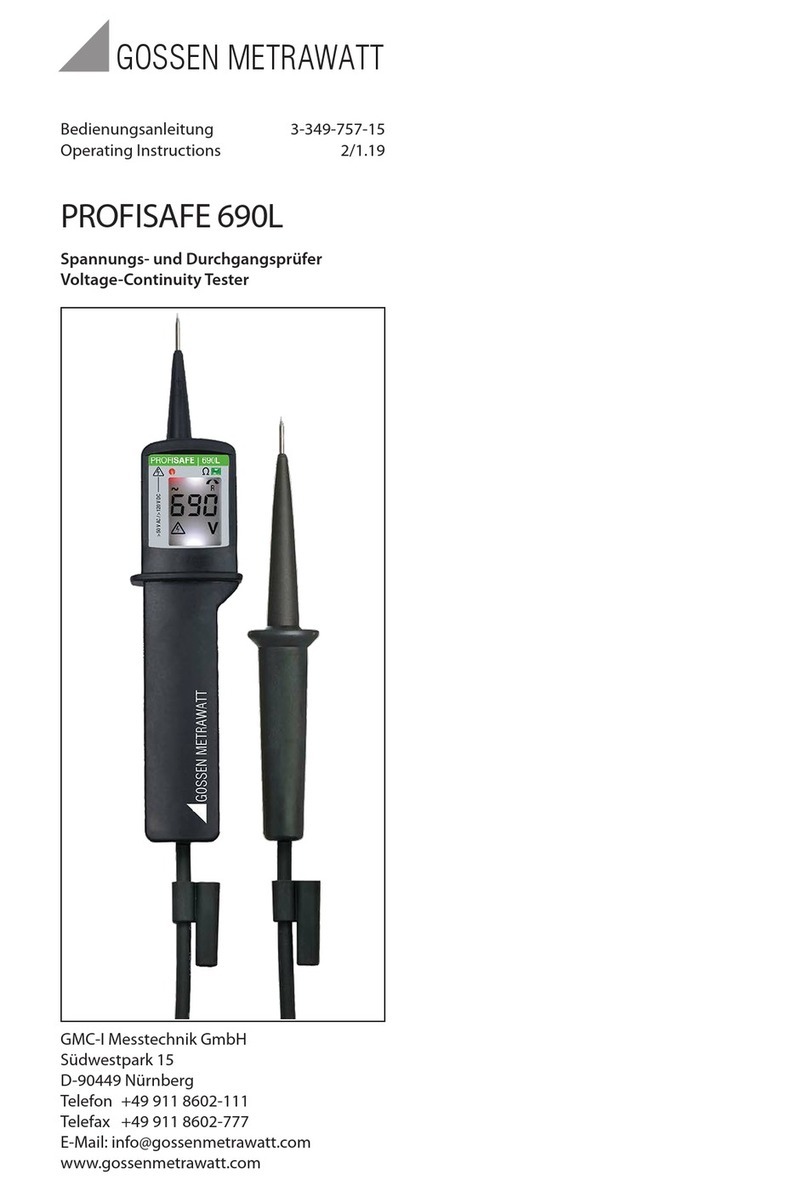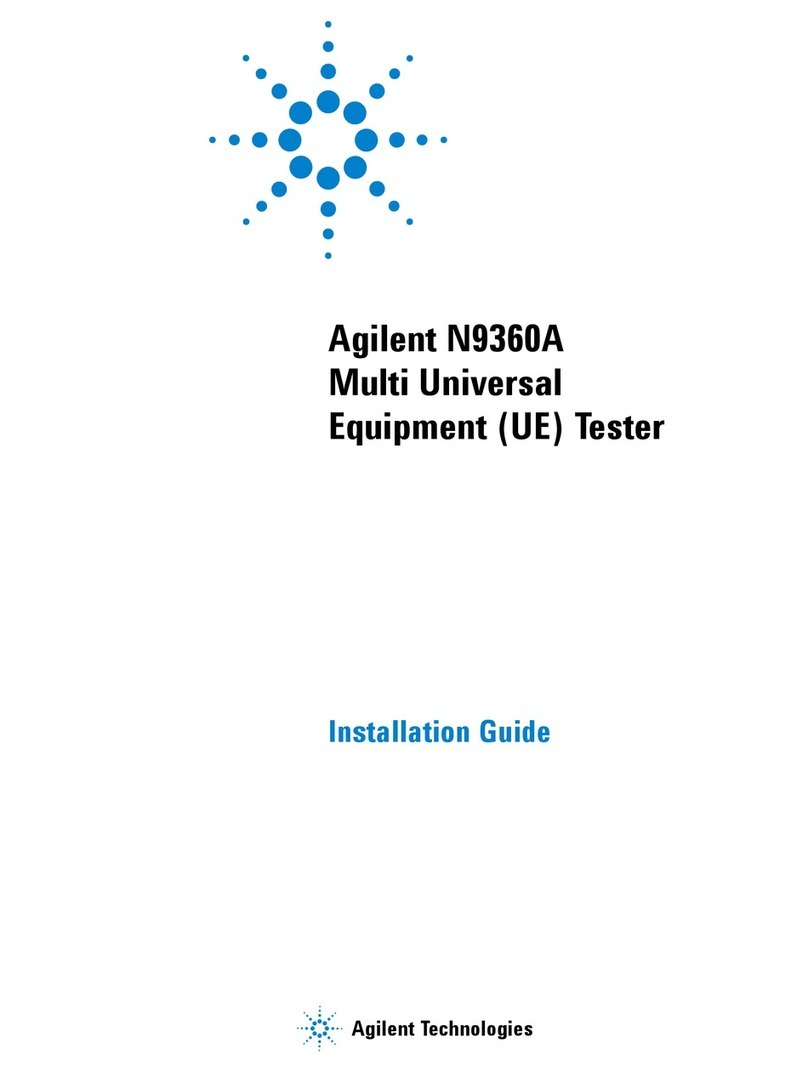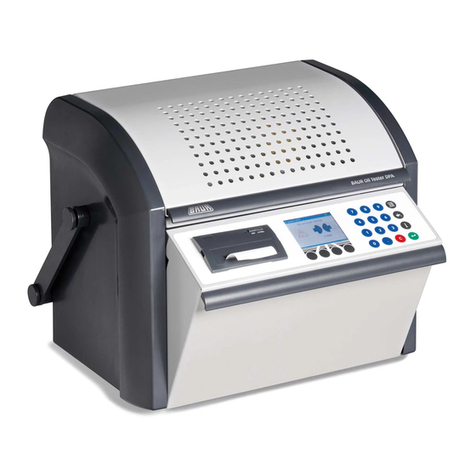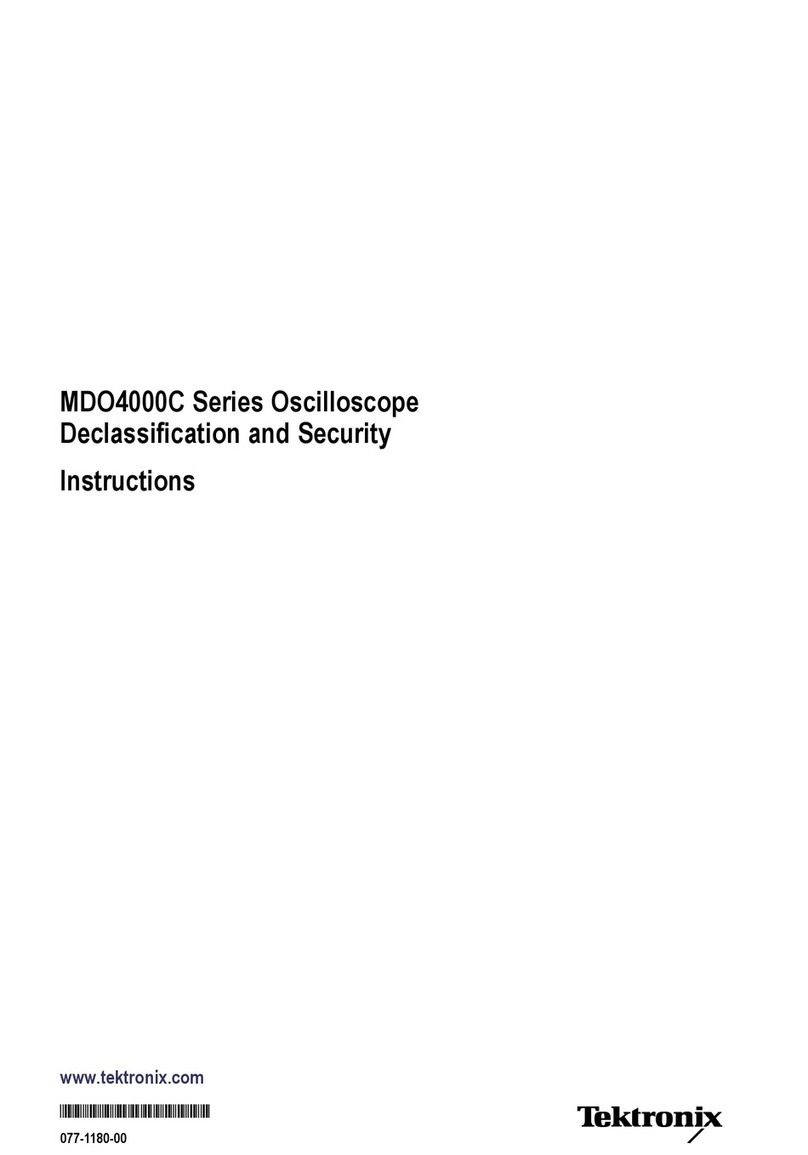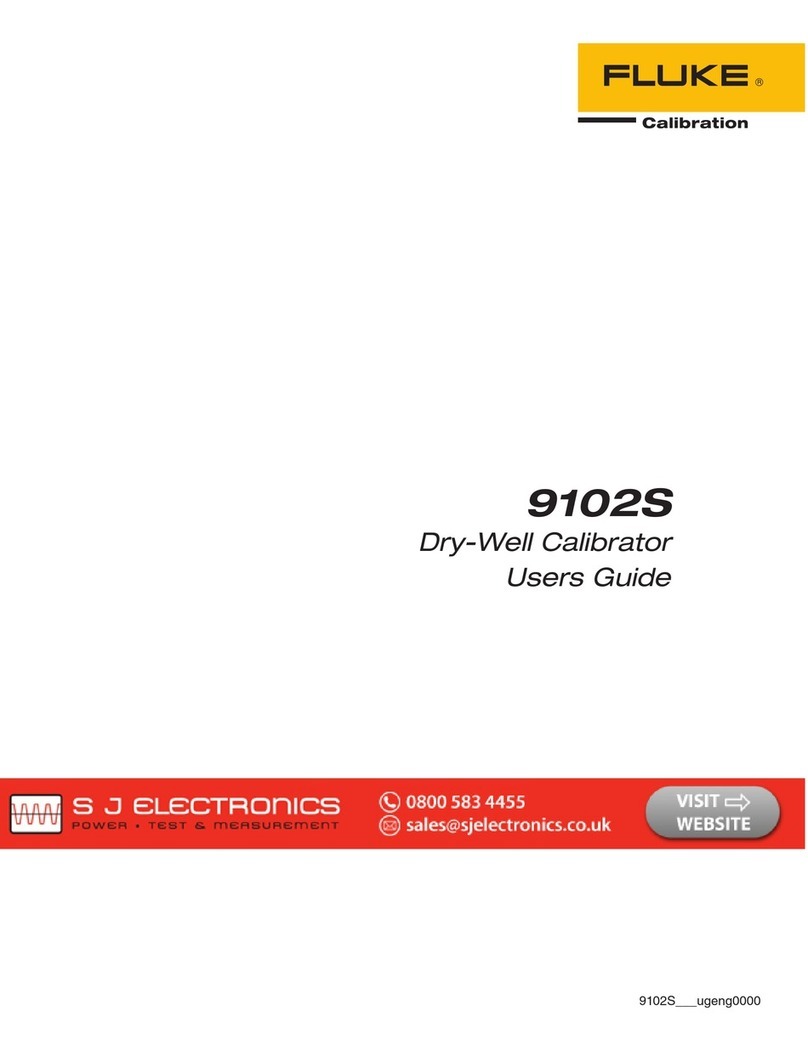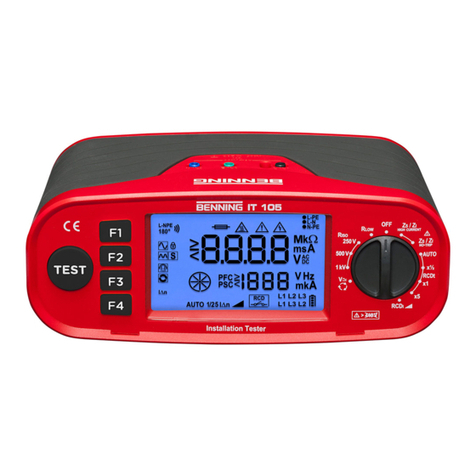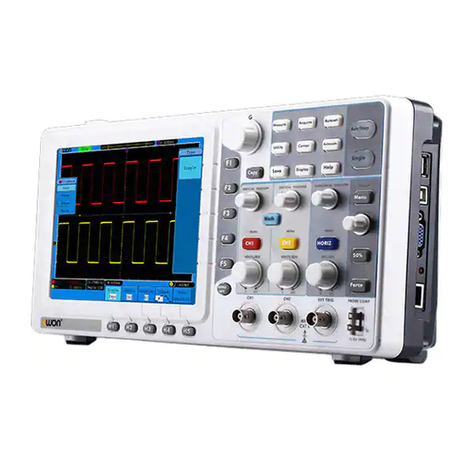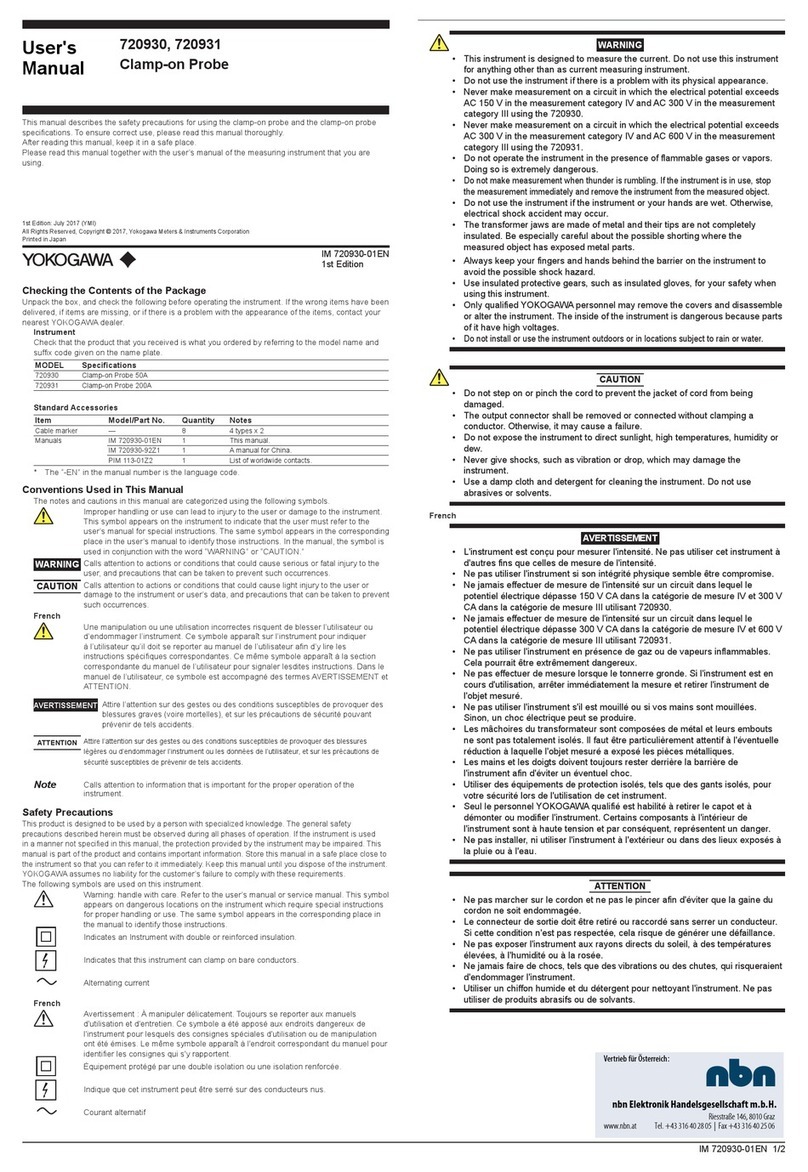Tescom ACT6000 User manual

ACT6000
Advanced Communication Tester
User Guide
January 2021

ACT6000 User Guide –January 2021 Page 2 of 52
ACT6000 Advanced Communication Tester
INDEX Page
1. General description...........................................................................................3
2. Safety and conformity information......................................................................4
2.1. Community directive 2002/96/EC..................................................................4
3. Functions and measurements type....................................................................5
3.1. Functions.....................................................................................................5
3.2. Measurement types......................................................................................5
3.3. Measure Saving & Export.............................................................................6
3.4. Power Supply and Battery charge.................................................................6
4. Technical Specifications....................................................................................7
5. Commands and Connections description......................................................... 14
5.1. Front panel Commands description.............................................................14
5.2. Upper panel Connections Description.........................................................15
6. Use mode (frequent commands, menu hierarchy)............................................ 16
7. LINE TESTS Pre-configured SELT Sequences (by ASW 1/II)........................... 17
7.1. LINE TESTS Pre-configured Single Transmissive Measurements................21
7.2. LINE TESTS Pre-configured DELT (End-to-End) Sequence ........................22
7.3. LINE TESTS Pre-configured Telephone DELT (End-to-End) Sequence........26
8. Subscriber Simulator....................................................................................... 27
9. TDR Fault Locator........................................................................................... 28
10. Events Tests................................................................................................... 30
10.1.Micro-interruptions Test..............................................................................30
10.2.Impulsive Noise Test..................................................................................31
11. Digital Multimeter............................................................................................ 32
11.1.DC/AC Voltage Measurement.....................................................................32
11.2.DC/AC Capacitance Measurement .............................................................32
11.3.Resistance Measurement (Loop and/or Insulation)......................................33
11.4.Low Insulation Localization (RFL) without extraneous voltage......................35
11.5.Fault Localization (RFL) with extraneous DC voltage...................................36
11.6.Resistive Balancement “R-bal” measurement..............................................38
11.7.Line / Load Impedance Response...............................................................38
12. Signal Analyzer & Generator ........................................................................... 39
12.1.Generator & Meter .....................................................................................40
12.2.Spectrum & Network Analyzer (for Base and Medium Band)........................41
12.3.Spectrum & Network Analyzer (for High Band)............................................42
12.4.Guide for generic manual transmissive measurements................................43
-RMS Noise in Base Band with Generator & Meter..............................................43
-Spectral Noise / Level with Spectrum Analyzer ..................................................43
-Power Spectral Density (with Spectrum Analyzer in High Impedance) ................44
-Return Loss with Network Analyzer...................................................................44
-Longitudinal Balance Attenuation with Network Analyzer....................................45
-Near End Crosstalk “NEXT” with Spectrum Analyzer..........................................45
-Insertion Loss meas. End-to-End manual or semi-automatic mode....................46
13. File Manager................................................................................................... 47
14. Configurations and Utilities............................................................................... 48
15. Appendix 2 - DPBO verification.......................................................................51

ACT6000 User Guide –January 2021 Page 3 of 52
1. General Description
The ACT6000 combines various kinds of transmission, metallic and special tests. It can be
considered to be the most advanced Test Set today for qualifying and maintenance of
advanced transmission systems and copper pairs used for various telecommunication
services: from VOICE to VDSL.
One of ACT6000’s most interesting features is the new high resolution color graphic
display, a real “window” on the most advanced measurements’ world.
The alphanumeric keypad, as well as the function-keys, grant to the instrument a high
operating level. Moreover, take note that, due to its accurate and intuitive “Human Machine
and Graphics User Interface”, this instrument needs the help of the user’s manual to
arrange and carry out unusual measurements and/or settings.
One ACT6000, suitably configured, can perform easily and quickly “Single-End Line Tests”
or very accurate “End-to-End Tests” together with another ACT6000. The wide range of
measurements of the ACT6000 allows the qualification and certification of various
communication carriers and copper pairs used for digital streams with a frequency span up
to 6 MHz (or 35 MHz optional); moreover, the instrument can automatically extrapolate the
ADSL and VDSL maximum expected data rate of the copper line under test.
ACT6000 can be configured for in-depth analysis, by special functions and internal optional
modules. The complete adoption of these modules allows the simple and fast finding of
anomalies and/or faults on the copper line and communication systems.
Package The package of the instrument (base version) contains: the soft-pack
carrying case, this User Guide, the AC / DC battery-charger,
Banana/Crocodile cables and Ground Cable. Make sure that, on receipt,
this pack and its contents have not been damaged by bumps or
careless handling. For possible shipment of the instrument for repair or
calibration it is suggested to use the original pack.
Instrument identification
The Part-Number, Serial Number, Hardware Configuration, and date of production or
Calibration are pointed out on the factory label applied on the rear panel.
Copyright advice
The information contained in this document is the property of TesCom and is supplied
without responsibility for mistakes and omissions. No part of this document can be
reproduced without the specific authorization of TesCom.
TesCom reserves the right to make modifications of any nature to the present document
without notice. All rights are reserved.
TESCOM
20200 Algreg St, Pflugerville, TX, USA
Tel. +1 - 800-888-1978
E-mail: sales@tescomusa.com / Web: tescomusa.com

ACT6000 User Guide –January 2021 Page 4 of 52
2. Safety and Conformity Information
The ACT6000 is intended for use by qualified personnel only.
The use of this tester is allowed in internal or external environments within the normal
human range of climatic characteristics (temperature and damp. It is recommended to work
with this tester within declared temperature limits (-5 ÷ +50°) and not in contact with water,
because it is not waterproof.
The ACT6000, like all the TesCom instruments, is "CE" certified for full electromagnetic
compatibility and safety. The stage In/Out (RTX connector) of the ACT6000 is designed for
use with circuits that have a maximum of 150 Vdc or peak AC wire-to-wire, or 75 Vdc or
peak AC wire-to-ground.
Warning ! The stage output of the instrument “TX connector” is not protected !
Failure to comply with these precautions or with specific warnings in this guide violates the
safety standards of design, manufacture, and intended use of the tester.
TesCom assumes no liability for the customer’s failure to comply with these requirements.
If this product is used in a manner not specified by the TesCom the protections provided by
the product may be impaired.
The RTX connector of the ACT6000 has an automatic protection device to protect against
over-voltage; over specified limits the protection activates and on the following message
appears on the display: WARNINGS!
OVER VOLTAGE PROTECTION
VERIFY LINE CONNECTIONS - PUSH ANY KEY TO RESTORE
To restore the operation of the instrument, after verifying the correct state of the line, press
any key. In every case, to ensure correct galvanic isolation of the instrument during the
execution of high impedance measurements Insulation or DC capacitance, disconnect from
the instrument: External AC/DC Battery Charger.
2.1.Community directive 2002/96/EC
Community directive 2002/96/EC for introduction in the market and to
disposal of “WEEE” (waste electrical and electronic equipments)
containing “RoSH” materials damaging to the environment and
detrimental to human health.
TesCom declares that all the materials, components, products supplied are fully compliance with
RoHS & Weee Directives. Nevertheless, the disposal of this equipment cannot be disposed as waste
but it has to be returned to the producer or to its official distribution network which will arrange to carry
out a separate collection.
In order to comply with what is mentioned above is stated that:
- even if the equipment does not contain dangerous elements listed on RoHS directives,
improper use could be detrimental to human health and damaging to the environment;
- the meaning of the symbol shown below and affixed on the equipment is to remind
that the same cannot be disposed of as “waste”;
- penalties are to be expected in case of an abusive disposing of the equipment.

ACT6000 User Guide –January 2021 Page 5 of 52
3. Functions and measurements type
3.1.Functions
The main functions of the ACT6000 are: Generator & Meter; Spectrum and Network
Analyzer; TDR fault locator.
To the above are added the following functions:
▪DMM plug & play module, for metallic measurements: AC/DC Voltage,
DC Resistance / Insulation, RFL, AC/DC Capacitance and Impedance response.
▪POTS-SUB plug & play module, for manual Subscribe Simulator and automatic
Telephone DELT sequence.
▪Instrument Configuration (General Setup, Display, Date, Hour, Cable type,
Software up-date etc.)
▪File Manager utility for files storage, management and export.
3.2.Measurement types
●Transmissive measurements:
▪Signal and white noise generation
▪Selective Level and Frequency measurements
▪Noise measurement (wide and weighted band)
▪Power Spectral Density in high impedance and “DPBO” test.
▪Return Loss measurement
▪Longitudinal Balance Loss measurement
▪Crosstalk Loss measurement
▪Insertion Loss measurement
▪S/N and Distortion (on base band) measurement
●Events test:
▪Impulsive Noise long term measurement;
▪Micro-interruptions long term measurement;
●TDR Fault location:
▪TDR real time measurement for faults and line length location;
▪TDR long term measurement to intermittent faults location.
By the adopting of the DMM optional module:
▪AC –DC Voltage;
▪AC –DC Capacitance;
▪DC –Resistance, Balancement, Insulation and RFL (Resist. Fault Location);
▪AC Impedance response.

ACT6000 User Guide –January 2021 Page 6 of 52
●Automatic measurements on pre-configured transmissive masks (ETSI or ANSI):
▪Single-End and End-to-End automatic test sequences for copper pair and
POTS link qualification and certification by the ASW-1/II (optional software).
3.3.Measure Saving & Export
All the results of the performed measurements can be saved on internal memory
exportable to the external USB Pen-Drive or PC (by the specific PC Utility) in .CSV *
format.
It is also possible to export the screenshot in .BMP format.
The above mentioned PC Utility (Windows compatible) is free for download on
https://tescomusa.com/pages/act6000-applications and useful to direct software uploading,
editing and direct uploading of Data Cables and Threshold Limits, and the downloading of
the CSV files saved on internal memory.
●Advanced Software 1/II (optional)
The adoption of the ASW-1/II adds some automatic measurements according to the pre-
configured standard ETIS and ANSI masks on which are pointed-out the threshold limits
and “Pass” / “Fail” indications:
- Automatic Single-End Sequence to perform the copper lines pre-qualification, with
length within 50 and 4,500 meters.
- Manual Single-End Measurements shown in real-time.
- Automatic End-to-End Sequence to perform the qualification also on very long lines or
voice/data cannels, using a couple of ACT6000s.
- Automatic Telephone End-to-End Sequence to perform the POTS link qualification
using a couple of ACT6000s.
3.4.Power Supply and Battery charge
When using the instrument without external supply, it is possible to check continuously the
state of charge of the batteries, thanks to the icon.
An acoustic beep indicates the low batteries charge.
The ACT6000 is fitted with a polarized socket “SUPPLY”for the connection to the AC
Power Supply Adapter for battery charge.
When the right DC voltage is supplied to the above mentioned socket, the charging status
is shown by the led on top panel:
Green led “Ready”or “prompt to charge”and yellow led “Charge”or
“batteries on charge”, at the final phase of charge, orange led “T.O.C.”or
“Top of Charge”. The lighting of the red led “Fault”means a temperature alarm of the
batteries or related charger circuits.
Note* The CSV files are compatible with the Windows Excel application to visualize and to edit
graphics and data base.

ACT6000 User Guide –January 2021 Page 7 of 52
4. Technical Specifications
General
Case........................................: ABS shielded for EMI / EMC compatibility.
Connections.............................: · "RTX" connectors IN/OUT and “TX” OUT triple
banana-jack;
· polarized connector for external supply;
· RJ-45/4 connector for headset;
· USB port for PC connector and RS232 (to service);
· USB for pen-drive connector.
Display.....................................: LCD color 320 x 240 pixel (1/4 VGA) backlit.
Power supply (internal).............: · rechargeable battery pack (green) NiMh, with life
of about 8 hours (typical), 5 hours (minimum).
· external: from 16,5 to 26,5 Vdc / max 2,5 Ah.
Dimensions and Weight............: 150 x 210 x 50 mm /1,5 Kg. (batteries included).
Temperature range...................: Operating: 0 +45° C. / Storage -20 +70° C.
Humidity range.........................: 5 90% non-condensing.
Overvoltage Protection…………: In/Out RXT connectors up to 150 Vdc / 140 Vpp.
Reference Frequency accuracy : · 1 ppm within the operating temperature 2 ppm/year.
Reference Level accuracy……..: · 0.025% within the operating temp. 0.025% / year.
CE mark - EMC …………………: Directive 2004/108/CE, 89/336/EEC, Decree 2007/194
CISPR 11, ISO 14253 and CEI EN: 61326/A1/A2, 55011,
61000-4-2, 61000-4-3, 61000-4-4, 61000-4-6, 61000-4-11.
Special Features and Setup......: ●Results storage on internal flash memory;
●Software update and Results Export on Pen Drive;
●PC Remote interface by USB port.
Level Generator
Sine output frequency range.....: · base band: from 20 Hz to 22 kHz;
· medium band: from 20 kHz to 6 MHz;
· high band (optional): from 20 kHz to 35 MHz.
Reference Frequency accuracy.: · 1 ppm within the operating temp. 2 ppm/year.
Reference Level accuracy.........: · 0.025% within the operating temp. 0.025% / year.
Frequency Resolution...............: 1 Hz up to 9.999999 MHz; 10 Hz over 10.0 MHz.
Frequency setup mode.............: manual on single frequency and step mode on
programmable band / steps.
Balanced output impedances....: · base band: 150, 200 and 600 Ω;
· medium band: 100, 110, 120, 135, 150 Ω;
· high band: 100 Ω.
Unbalanced output impedances: 50, 55, 60, 68 and 75 Ωby Banana/BNC optional adapt.
Output level –Base Band……..: ·-70 ¸+14 dBm @ 600 Ωbalanced / 0.1 dB steps;
· -64 ¸+17 dBm @ 75 Ωunbalanced / 0.1 dB steps.
Output level –Medium Band.....: ·-64 ¸+20 dBm @ 100 ¸150 Ωbalanced / 0.1 dB steps;
· -64 ¸+17 dBm @ 50 ¸75 Ωunbalanced / 0.1 dB steps;
Output level –High Band (opt.).: · 0 dBm @ 100 Ωbalanced;
Output level –High Band (opt,).: · 0 dBm @ 50 Ωunbalanced.

ACT6000 User Guide –January 2021 Page 8 of 52
Output level accuracy...............: · base band: 0.2 dB from 50 Hz to 20 kHz @ 600 Ω;
· medium band: 0.2 dB up to 2 MHz, 0.3 dB up to
6 MHz @ 100 Ω;
· high band: 0.5 dB up to 10 MHz, 1 dB up to 35 MHz
@ 100 Ω.
Level Meter
Frequency range......................: from 50 Hz to 6 MHz (two bands) base version;
up to 35 MHz *
Manual tuning / resolution…….. : 1 Hz up to 9.999999 MHz; 10 Hz over 10.0 MHz.
Level measurement mode…… : absolute (dBm, dBV, dBu,Volt) and relative (dBr).
Reading resolution………………: 0.1 dB
Input range…………………...….: base band: -110 ¸ +10 dBm @ 1 kHz / 600 W;
medium band: - 120 ¸ +12 dBm @ 1 MHz / 120 W;
high band *: -70 ¸ +5 dBm @ 10 MHz / 100 W;
Level meter accuracy……….…. : · 0.2 dB from 100 Hz to 20 kHz @ 0 dBm / 600 W;
· 0.2 dB up to 2 MHz, 0.3 dB up to 6 MHz; @ 120 W;
· 1 dB up to 10 MHz, 1.5 dB up to 35 MHz *@ 100 W.
Noise floor (TX OFF)…………...: · £ -140 dBm/Hz up to 6 MHz;
: · £ -100 dBm/Hz up to 30 MHz.
Frequency Meter sensitivity……: -40 dBm for base and medium band.
Input impedances balanced......: · base band: 150, 200, 300, 415, 600 W and >10 kW;
· medium band: 100, 110, 120, 135, 150 W and >10 kW;
· high band *: 100 W and > 5 kW.
Input impedances unbalanced : · base and medium band: 50, 55, 68, 75 W and >10 kW;
by Banana/BNC adapter ·high band *: 50 W and >5 kW.
Noise filters………………..……. : · base band: wide band, Psophometric; C-Message;
300 3400 Hz, 20 3400 Hz, 300 Hz 6.0 kHz, 20 Hz
6.0 kHz, 300 Hz 15 kHz, 20 Hz 15.0 kHz, 300 Hz
20.0 kHz, 20 Hz 20.0 kHz and 20.0 kHz flat.
· medium / high band *:E, F, G / VDSL 1 –2 and Plus.
Selective filters / notch………… : · base band: (200 Hz 20 kHz) pass band and notch
for S/N+D (dB and %) test;
Selectivity: 10 Hz @ fo <200 Hz, 5% fo @ >200Hz fo
<4 kHz, 200 Hz @ fo >4 kHz.
Selective for telegraph. chann.: 120, 240, 360, 480 Hz.
· Medium / high band *(20 kHz 6 or up to 35 MHz):
25, 100, 200, 400 Hz and 1.74, 3.1, 4.0, 8.0, 16.0 kHz.
* By EBM30 optional module (ACT-13)

ACT6000 User Guide –January 2021 Page 9 of 52
Spectrum and Network Analyzer
Frequency range......................: from 200 Hz to 6 MHz (two band) base version;
up to 35 MHz 1)
Input / Out*impedances balance:· base band: 150, 200, 300, 415, 600 W and >10 kW;
· medium band: 100, 110, 120, 135, 150 W and >10 kW;
· high band 1) 100 W and > 5 kW.
Input / Out*impedances unbal..: · base and medium band: 50, 55, 68, 75 W and >10 kW
by Banana/BNC adapter ·high band 1): 50 W and > 5 kW.
Level reading mode..................: absolute (dBm, dBV, dBu,Volt) and relative (dBr).
Measurements readout.............: normal, peak (max, mean or minimum value),
Measurement mode……… .......: base and medium bands:
2 Wires +/-(for Return-Loss measurement);
2 Wires +/+ (for Longitudinal Balance measurement);
and 4 Wires (separate RX and TX).
High band 1): 2 Wires for Return-loss meas. / 4 Wires.
Input range...............................: from noise floor ÷ +12 dBm @ 100 Ω.
Noise floor................................: ≤-140 dBm/Hz.
Resolution vertical………..........: 192 pixel / 8 div.: 1, 2, 3 20 dB / division.
Resolution marker....................: 0.1 dB / as selected resolution (BW).
*Tracking Level Generator…….: in sweep or single frequency in 2/4 wires mode;
Output Level & Resolution same of Level Generator.
White Noise Generator…………: 1 kHz 6 MHz / -74 -144 dBm/Hz / 0.1 dB steps
·Base band range……….........: 200 ¸ 25000 Hz, by FFT analyzer (Kaiser window).
Span……………………….. .....: 6250 Hz (and zoom / 2 ), 12500 Hz and 25000 Hz.
Resolution horizontal…….. .....: 250 pixel / 10 div. : 625 + zoom, 1250, 2500 Hz / division.
Resolution (BW)…………........: 50, 100, 200 .. Hz (other resolutions are interpolated).
·Medium band range..............: 1 kHz to 6 MHz, by Digital SSB quad. Conversion.
Span......................................: 30 ranges: from 10 to 8000 kHz, 10 per decade.
Resolution hor. on display.......: 250 pixel / 10 div: 1, 2, 4, 8, 16.. 800 kHz / division.
Measurement hor. resol….......: 1000 points (available on saved and exported CSV file).
Resolution (BW).....................: 0.2, 0.5, 1, 2, 5, 8 kHz (other resolutions are Interpolated)
Max level frequency readout...: up to 10 Hz resolution on 1 kHz / Division.
·High band *range.................: 20 kHz to 35 MHz, by double conversion receiver in four
bands: 0.02 to 12, to 18, to 30 and to 35 MHz.
Resolution horizontal..............: 250 pixel / 10 div: 1.2, 1.8, 3 and 3.6 MHz / division.
Mix measurements Generator/Meter and Network Analyzer
· Cross-Talk (4 Wires)
Test by Generator & Meter…..: NEXT (in Single-End mode) and FEXT (in End-to-End
mode) on single frequency.
Test by Network Analyzer ......: NEXT (in Single-End mode on single frequency or wide
band by tracking generator) and FEXT (in End-to-End
mode) on single frequency or on wide band using the
frequency Step Generator and sample & hold Spectrum
Analyzer.
1) by EBM30 optional module (ACT-13)
Frequency range TX and RX..: 200 Hz 6 MHz, up to 35 MHz *

ACT6000 User Guide –January 2021 Page 10 of 52
Impedances TX and RX.........: same of the Signal Generator & Level Meter, excluded
the high impedances.
Measurement accuracy..........: · up to 2 MHz: 1 dB / between 0 -90 dB;
· up to 6 MHz: 2 dB / between 0 -86 dB;
· up to 35 MHz *: 3 dB / between 0 -80 dB.
Intrinsic crosstalk…………….. : <- 90 dB (with precise resistive load).
· Return Loss (2 wires)
Test by Network Analyzer ......: in Single-End mode on single frequency or wide
band –spectral readout, by tracking generator.
Frequency range TX and RX..: 200 Hz 6 MHz, up to 30 MHz *
Impedances TX and RX.........: same of the Signal Generator & Level Meter, excluded
the high impedances.
Measurement accuracy..........: · up to 2 MHz: 1 dB / between 0 -50 dB;
· up to 6 MHz: 2 dB / between 0 -46 dB;
· up to 30 MHz *: 3 dB / between 0 -40 dB.
· Longitudinal Balance Loss (2 Wires + Gnd)
Test by Network Analyzer ......: in Single-End mode on single frequency or wide
band –spectral readout, by tracking generator.
Impedances TX and RX.........: same of the Signal Generator & Level Meter, excluded
the high impedances.
Frequency range...................: 200 Hz 6 MHz.
Measurement accuracy..........: · up to 2 MHz: 1 dB / between 0 -60 dB;
· up to 6 MHz: 2 dB / between 0 -56 dB.
· Single-End Insertion Loss (available on the automatic SELTest sequence) **
Measuring Mode / readout......: by FDR technology on High-Band / Spectral readout.
Operating limits......................: ·minimum line length: 50 meters;
·max. line length: 4.5 km on Ø wires 0.4 mm.
Graphic Extrapolation.............: 1 kHz 6 MHz or up to 35 MHz *.
Accuracy................................: 1 dB up to 2.2 MHz; 2 dB up to 35 MHz *.
* by internal optional module EBM30 (ACT-13)
** by optional Advanced Software ASW 1/II
Event Tests
· Micro-Interruptions - O.62 in base band and medium band
Threshold level......................: -3 -20 dB -2 kHz Test Tone (default) or on
programmable input frequency up to 6 MHz.
Monitoring time......................: 4 min. 24 ours.
Events indicators...................: 5 Counters (0.3ms >1min); Event/Time; Secs. with
Events.
Readout................................: Tabular and Time Domain Histogram representation.
Measure facilities...................: 2 kHz reference tone output from TX connector for
loopback tests.
· Impulsive Noise O.71 in base band
- Threshold level.......................: 0 -60 dBm.
- Base band BW filters...........: 200 12000 Hz Flat, 600 3000 Hz, 300 500 Hz.

ACT6000 User Guide –January 2021 Page 11 of 52
- Monitoring time....................: 4 min. 24 hours.
- Events indicators.................: 1 Event Counter; Event/Time Ratio; Secs. with Events.
- Readout..............................: Tabular and Time Domain Histogram representation.
Special Measurements
· Line Immunity by White Noise injection (available on Network Analyzer)
- Output level range...............: -70 ¸ -144 dBm/Hz @ Zref 100 W - 0.1 dB Resolution.
- Output impedance...............: 100, 120, 135, 150 and 1350 W (balanced).
- Band width .........................: 1 kHz 6 MHz.
· TDR Fault locator
Distance ranges………………...: 90, 180, 450, 900, 1800, 3600, 7200 m. @ 0.600 PVF.
Zoom……………………………..: vertical: -8 ¸ +77 dB; horizontal : 1x, 2x, 4x.
Distance resolution (by marker) : ·minimum range: about 0.4 meters (or 1 foot);
·maximum range: about 40 meters (or 100 feet).
Operative mode…………………: single line (2 wires), Crosstalk (4Wire), Differential by
relative comparison with other line; Monitoring to
events localization by Peak mode (Sample & Hold).
Pulse output level……….……. : short and long: 2.2 Vpp; Boost: 5.5 Vpp.
Pulse length…………………… : automatic on range selection, from 10 to 5000 ns.;
IN/OUT impedance…..…………: 100, 110, 120, 135, 150 W (balanced)
TGC (automatic gain control).. : 0 ¸ 6 dB/km.
Propagation velocity………….. : PVF: 0.300 to 0.999 or PV (90 to 300 m/µs)
· Digital Multimeter DC / AC (by DMM –ACT-12 optional module)
Measuring mode.......................: between a-b; a-c (Gnd); b-c (Gnd) and reverse.
DC Voltage, Range / Accuracy..: 0 140 Vdc / 2% of reading 1 digit.
AC Voltage, Range / Accuracy..: 0 100 Vrms / 2% of reading 1 digit / 153300 Hz.
DC LOOP RESISTANCE / INSULATION
- Test Voltage...........................: 100 Vdc (with current limit 1mA max).
- Range Loop Res./ Accuracy ...: 2 5 K/ 2% of reading digit.
- Range Insulation / Accuracy ...: 2 1 G/ 2% of reading digit.
LINE LENGTH BY LOOP RESISTANCE
- Line length evaluation/ accur. .: (as function of measured loop resistance).
- Line Gauges setting................: from 0.2 to 2.5 mm or from AWG 26 to AWG 11.
- Multi-section setup .................: up to 5 different cables type.
- Line Resistance correction......: from 1.01 to 1.60 x standard copper resistance.
- Line Temperature setting........: set from -20° +60° C.
- Range / Resolution.................: 0 to 99.999 kUnits (meters or feet) / 1 units.
RESISTANCE METER (real time) (by optional module ACT-18 installed on DMM module)
Range / Resolution / Accuracy..: 0.1 to 50 k/ 0.1 up to 999.9 / 2% 1 digit.
RESISTANCE balance / acc…..: shorting a-b-c (gnd) / with >5 unbalance.
RFL (Resistance Fault Locator)
- Loop resistance.....................: 1to 5 kmaximum.
- Multi-section facility ...............: as the setup for Loop Resistance.
- Fault resistance.....................: from 5 to 20 Mmax.

ACT6000 User Guide –January 2021 Page 12 of 52
- Accuracy of RTF @ 1 M......: 0.5% of Loop resistance.
DC CAPACITANCE (time of DC discharge method)
- Test Voltage...........................: 100 Vdc.
- Range / Accuracy..................: > 10 nF 10 F / 5% of reading 1 digit.
AC CAPACITANCE and Q factor (by capacitive bridge)
Measuring mode.......................: by 1 kHz tone –1.1 Vpp between: a-b;.
Range / Resolution...................: 0.1 to 3000 nF / 0.1 nF.
Accuracy..................................: ±1% of reading ± 1 nF @ C <500 nF;
±5% of reading ± 1 digit @ C >500 nF and < 3000 nF.
LINE LENGTH BY CAPACITANCE
Line length estimation...............: (as function of measured capacitance):
Line Capacitance setup............: 10.0 to 300.0 pF / Length Unit.
Range / Resolution / Accuracy..: 1 to 99999 Units (m. or ft.) / as from capacitance meas.
LINE IMPEDANCE RESPONSE
Measuring range ...................: from 30 to 3200 Ohm in five steps.
Frequency Range..................: from 5 kHz to 5 MHz in four steps.
Accuracy...............................: ±5 % ±5 Ω.
· POTS Subscriber Simulator (by optional module ACT-11 installed on DMM module)
Dial Encoder ............................: ·Pulse, progr. duration/ratio (100 ms / 40/60%);
·DTMF std. tones, progr. Level, Duration, Inter-tone.
Ring Detect. Range & Meas......: Level: 10 ÷ 90 Vrms; Frequency: 15 ÷ 70 Hz.
Ring Detector AC Load.............: R 7310 Ω± 2% in series + 940nF ±10% capacitor.
Ring current self limitation........: ≤15 mA peak ; safety fold-back limited.
On Hook / Break & Make specs.: R = 120 Ω±2% @ I = 100 mA; Voffset = 4 Vdc.
Automatic pre-configured SELTest sequence for line pre-qualification *
With single ACT6000 - Single-End Tests on open line, 2 or [4] Wire mode:
Metallics: AC / DC Voltage, DC Insulation, AC / DC Capacitance, Q, End-Of-Line (TDR).
Transmissive (wide band / spectral): Noise (local), Return-Loss, Longitudinal Balance-
Loss, “FDR” Insertion-loss & frequency response estimation, Noise (far-end estimation),
[NEXT], and SNR prediction, Bit-Rate prediction for ADSL - ADSL2+ - VDSL2 and VDSL
Plus** masks.
Manual pre-configured SELTest *
Transmissive (wide band / spectral readout) measurements:
Noise, Return-Loss, Longitudinal Balance-Loss, NEXT and PSD (sniffer mode).
*by Advanced Software ASW-1/II;
** by adoption of EBM 30 (ACT-13) optional module;
Automatic pre-configured DELTest sequence for line qualification & certification *
With two ACT6000 (Master/Slave mode) for End-to-End Tests, 2 or [4] Wire mode:
Only Transmissive (wide band / spectral): Noise (bilateral), Return-Loss (bilateral),
Longitudinal Balance-Loss (bilateral “LCTL”), Insertion-Loss, [NEXT and FEXT] and Bit-

ACT6000 User Guide –January 2021 Page 13 of 52
Rate evaluation (Up & Down stream) and SNR for ADSL - ADSL2+ - VDSL2 - VDSL
Plus** masks.
Automatic pre-configured Telephone DELTest sequence *(with two ACT6000 in
Master/Slave mode) for POTS link qualification *** by Signaling and Transmissive tests
according to the M.1040 voice mask.
Pre-configured masks for manual SELT or SELT / DELT line tests sequences *
· Wide band: VOICE, MODEM 56k, ISDN, HDSL 1p and 2p, E1, T1, SHDSL, ADSL,
ADSL2+, and VDSL2-12a, VDSL2-17a, VDSL2-30a, VDSL Plus **.
For VOICE and MODEM 56K is allowed the special DELT modality “EIA-464 4W E&M”
to perform the Insertion-Loss and Noise level on special PCM systems with separate TX
and RX unidirectional channels.
DBPO Masks - Automatic generation of the Threshold Mask for VDSL related to the
primary line parameters included the “ESEL” measured by ADSL2+ SELT Sequence *
Notes:
*by Advanced Software ASW-1/II;
** by adoption of EBM 30 (ACT-13) optional module;
*** by adopting the ACT-11 “POTS –SUB” Module installed on the ACT-12 “DMM Module”.
Supplied Accessories (base kit):
ACT6000 Base Instrument, included:
- Nylon Carrying Case with pocket for accessories;
- User Guide (English or Italian language, as requested);
- AC Power Supply and Battery Charger (Line Input: 100-220 Vac; Output: 20 Vdc);
- Banana-Banana + Crocodiles cables (2.30m total length);
- Ground Cable unipolar Banana-Crocodile cable;
Extra cost Accessories and Optional HW/SW Modules
-ASW-1/II - Advanced Software 1 (see the above description).
- ACT-11 POTS Module (Subscriber Simulator for POTS for signaling tests);
- ACT-12 DMM Module (Digital Multimeter for metallic tests);
- ACT-13 EBM30 Module (Extension Band for 35 MHz operation);
- ACT-14 USB Pen-Drive 8 GB;
- ACT-15 Probes to perform Medium & High Band PSD measurement on fed lines;
- ACT-16 Plug/Probes to perform Medium & High Band PSD measurements on fed lines.
- ACT-17-B 50 dB Balanced Attenuator, High Z input / 150 Ohm output;
- ACT-17-U 50 dB Unbalanced Attenuator High Z input / 75 Ohm output, included coaxial
cable tests BNC/BNC 75 Ohm;
- ACT-18 Real Time Resistance Meter module;
- ALT-05 Headset with 2m cable and RJ-45/4 connector;
- ALT-09 Resistive Termination Set (100, 120, 135, 150 and 600 W);
- ALT-16 Triple Banana to BNC Adapter, included coaxial cable tests BNC/BNC 75 Ohm.

ACT6000 User Guide –January 2021 Page 14 of 52
5. Commands and Connections description
5.1.Front panel Commands description
1- (Power) Key for switching On/Off.
A short press of this key switches ON the instrument, while a long press
switches Off.
2- (Hold) Key for the temporary freezing of the measurement. This command
allows access to a “Save” function to store and/or export the file measurement.
3- (Talk) Key for enabling the intercom circuit; this command enables only the
microphone, as the headphone is always enabled. This command switch the
Line Hook-Off / Hook-On when the POTS Subscriber Simulator is activated.
4- Commands group plus selection function (as “Enter”), for menu
selection and parameters setting.
5- Keys group for the setting of alpha-numerical parameters.
6- (Clear) Key for cancellation, it enables the ability to export the screen shot
In BMT format to the USB Pen-Drive.

ACT6000 User Guide –January 2021 Page 15 of 52
7- (Enter) Key for selection / confirmation.
8- (Escape) Key for exit and return to previous state.
9- Function keys group (the associated function is highlighted in the
relevant area of the display).
10-Multi-functional key for temporary adjustment of the brightness / contrast of the
display and for switching On/Off of the internal loudspeaker.
11-Key for software release and instrument information.
BATT. Rubber corner protection of the battery compartment.
5.2.Upper panel Connections Description

ACT6000 User Guide –January 2021 Page 16 of 52
6. Use mode (frequent commands, menu hierarchy ..)
Frequent Commands
The ACT6000’s human interface is very intuitive due to the displayed info.
The function keys (F1 - F5), allows various configurations or facilities related to the specific
menu.
Wen turned on, the Main Menu is displayed
where the various types of selectable
measurements or functions and other
configuration menus are shown.
On the Main Menu the date & time are
shown battery status, loudspeaker /headset
enable.
The selection of any item is made by the
use of the arrows of the commands
group or by pressing the associated
number on the keypad.
In most of the active menus it is possible to adjust the LCD brightness / contrast and
volume loudspeaker through the key and the of the commands group.
When a menu is selected, by the commands group, to access the next menu it is
necessary to confirm the choice with the (Enter) key;
if the selection takes place by the keypad, the entry to the next menu is straight forward.
Return to a previous menu is always allowed by the (Escape) key.
By pushing the “Photo” key, the measurement can be temporarily frozen and a
special function-key will be enabled to save the measurement on the internal memory. By
pushing the key the measurement will be reactivated.
Where possible, pushing the (Cancel) key allows the immediate upload the
screenshot to the Pen-Drive or PC (image in BMP format).
Note:
Depending on the software release or the unavailability of some functions or internal
optional modules the related selection may not be available.

ACT6000 User Guide –January 2021 Page 17 of 52
Menu Hierarchy
7. LINE TESTS Pre-configured SELT Sequences (by ASW 1/II)
By the “Advanced Software 1”and DMM module it is possible to perform a
complete and automatic line qualification with single ACT6000 placed on C.O.
MDF or Street Cabinet.
To perform this test is necessary disconnect any xDSL or active device (modem, router or
cordless) at the opposite side (user side) of the line to be test.
Connect the line to the a- bpoints and “earth” (GND) reference to the cpoint of the RTX
connector; if Cross-Talk measurement is needed, connect the second line to the
a- bpoint of the TX connector. Disconnect the AC/DC battery charger !
Before the Test Configuration is suggested to verify (by TDR in manual mode …see at
page 27) the correct the echo of the “end line” from which it is possible to verify the
congruence of the presumed line length after the selection of the preponderant cable type
(…see 8. Cable Setup at page 48).

ACT6000 User Guide –January 2021 Page 18 of 52
Instrument Configuration (only if necessary…) From the Main Menu select and enter on
the “7. Config & Utility”menu, then select and
enter on the “1. BALANCED LINE TEST”:
- Verify the selected Cable type from the
Cable Setup menu: Cable Name, Line
Capacitance/km, Conductor Diameter,
PVF (for the TDR) and the Eps relative.
- the Bit/Symb for the right ADSL or
VDSL*Bit-Rate evaluation.
- the presumed far-end Noise Floor.
- the Noise Margin for the right ADSL
or VDSL*Bit-Rate evaluation.
- the Noise measurement repetition **.
- the ETSI or ANSI standard masks.
Note * with the adoption of the EBM30 –ACT-13 optional module.
** Increasing the Noise Repetition test, from 1 (short time) to 60 (long time), the accuracy of
the final RMS Noise measurement will be increased.
To increase the accuracy of the SELT Insertion-Loss is suggested to adjust (before) the
correct copper resistance value (Ohm/km) of the line under test by the R-Set (page 30).
Test configuration
From the Main Menu, select and enter the 1.
Line Tests item, then select and enter on 1.
BALANCED LINE TESTS, and:
by F1 key select 1 or 2Pair mode.
2 Pairs performs the NEXT (Near
Cross Talk) measurement.
In this case the tracking reference signal (to
disturb) is available on the TX connector.
By F3 key it is possible to select the transmissive measurements related to
the specific mask and threshold limits (with pass/fail indication):
-VOICE, ISDN, HDSL, SHDSL, E1 and T1 on Base and Medium
Band referring to the right limited band and single reference frequency i.e. by
Nyquist formula.
-ADSL, ADSL2+, VDSL2 and VDSL Plus on Medium or High Band
(if the EBM30 module is installed) referring to the right limited band and
frequency marked on 300 kHz for ADSL, 1.1 MHz for ADSL2+, 6 MHz for
VDSL2-12, 8 MHz for VDSL2-17, 15 MHz for VDSL2-30 and 17.5 MHZ for
VDSL Plus.
Automatic SELT start
Push the F5 “Start”key to perform the Single-End-Line-Test sequence.
Warning! During the sequence don’t manage the line (a-b) or “ground” (c) connections.

ACT6000 User Guide –January 2021 Page 19 of 52
Test results (after about 90 seconds from the start)
During the test sequence it is shown step by
step that any single electric value can be
measured between a - b and cpoints.
For the low extraneous AC/DC Voltages *and
low Resistive Insulation (among a-b-cpoints)
are shown the worse values, as highlighted on
the image at left for the low insulation value
between a - b points.
All the transmissive measurements are only
between a - b points.
Under the “Subscriber” column, the estimated
values are shown (i.e. Far-end Noise* and
ADSL down stream estimation).
Once the automatic test is finished, push the F1 “Save”key to save the summarizing table
and all the hidden details (spectral / graphics responses included) on the internal memory.
By pushing the “Clear” key, it is possible to export the screen-shot to the USB Pen-
drive or PC in .BMP format.
* if found an extraneous voltage over 2.0 Volt, some measurements will be blocked !
Noise note: The results of the Noise RMS (local and remote estimation for the ADSL, ADSL2+ and
VDSL) are weighted with the right filters depending to the selected line service and masks (e.g. “G3”
for the ADSL2+).
Note: Pass/Fail indications
If some measured value is out of the preconfigured threshold limits the value will be shown in red.
- When the DC Capacitance value is abnormal (e.g. ≥700 nF ) and highlighted, it is probable that the
line is terminated with one or more telephones or similar POTS devices (due the ring capacitor)
- When the line length estimated by TDR is incongruent with the typical AC or DC line capacitance or
however it is out of the TDR range, the Line End, Ins. Loss and Bit-Rate results can be wrong and
will be highlighted in red.
Details visualization If Metallic Measure is selected on the previous
menu, pushing the F5 “View”key will open a
page where the detailed measured electric
values as at left shown:
- AC (as AC line power influence);
- DC Voltage, Resistive Insulation;
- DC and AC line Capacitance, both with
the estimated Line Length “EoL” related
to the previous setup on the “Config. &
Utility” menu.
By pushing arrow it is possible to view the graphs of other transmissive measurements,
as follows:

ACT6000 User Guide –January 2021 Page 20 of 52
Notes:
* Return-Loss: Due to the impossibility to terminate the line-end for this Automatic Sequence, in some
cases the bad result of the R.L. can be false, above all when the line under test is short (under 500 -
700 meters) or when selected a Base Band mask (Voice or MODEM 56k).
In this case it is suggested to apply the termination at the line-end (i.e. 600 Ohm for Base Band
masks) and perform the R.L. measurement as single test …see 7.1
** Insertion Loss: The threshold limit (decreased of 2 dB) is referred to the typical good line with
same length, capacitance and gauge wires.
Local Noise and its remote
estimation, transferred to
the presumed noise floor.
Return-Loss with marker on
the related frequency
reference (1.1 MHz) *
Longitudinal Balance Loss
with marker on the worse value
of the band.
TDR echogram with marker on
estimated Line End (open) at
2028 m.
Insertion Loss with marker on the
related frequency reference (1.1
MHz) **.
Signal-to-Noise Ratio (bit rate)
where are highlighted any DMT
channel amplitude.
Table of contents
Other Tescom Test Equipment manuals
Popular Test Equipment manuals by other brands
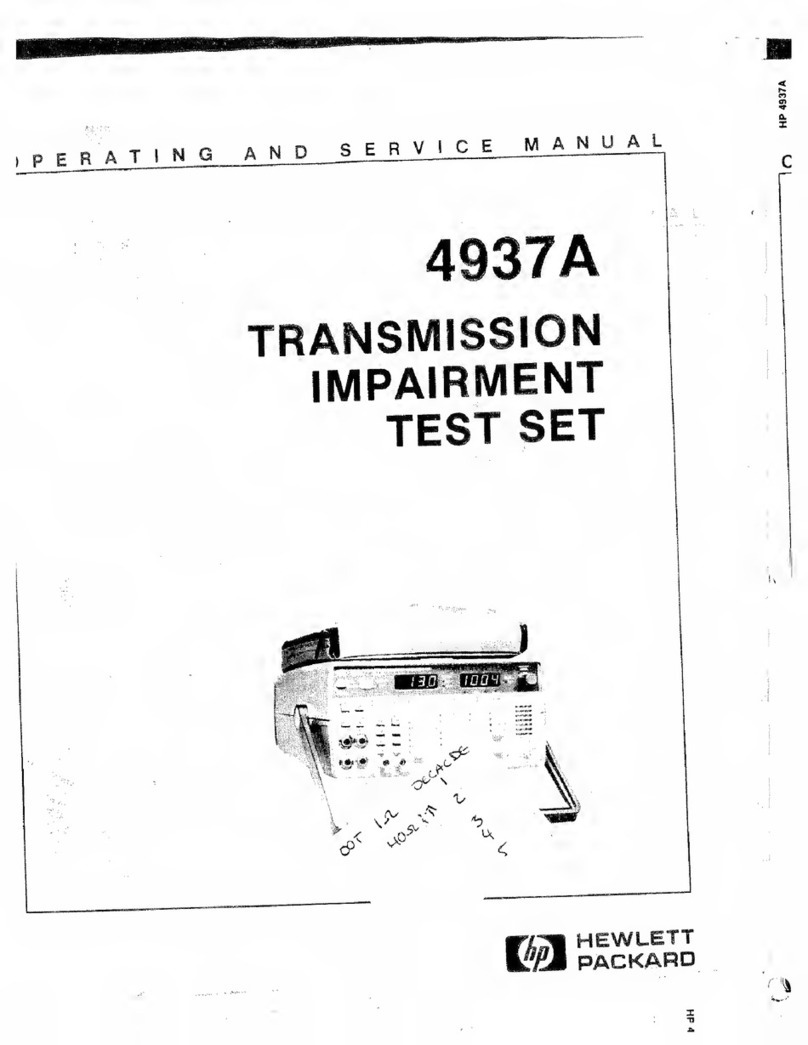
HP
HP 4937A Operating and service manual
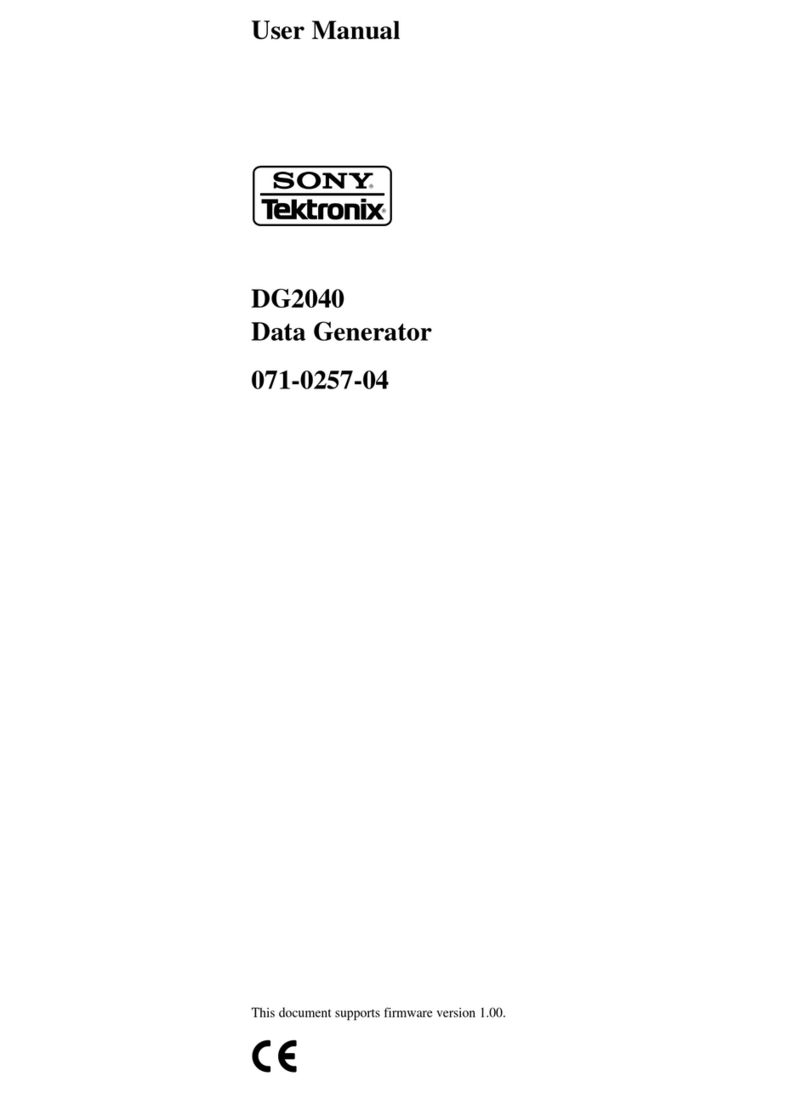
Tektronix, Inc.
Tektronix, Inc. DG2040 user manual
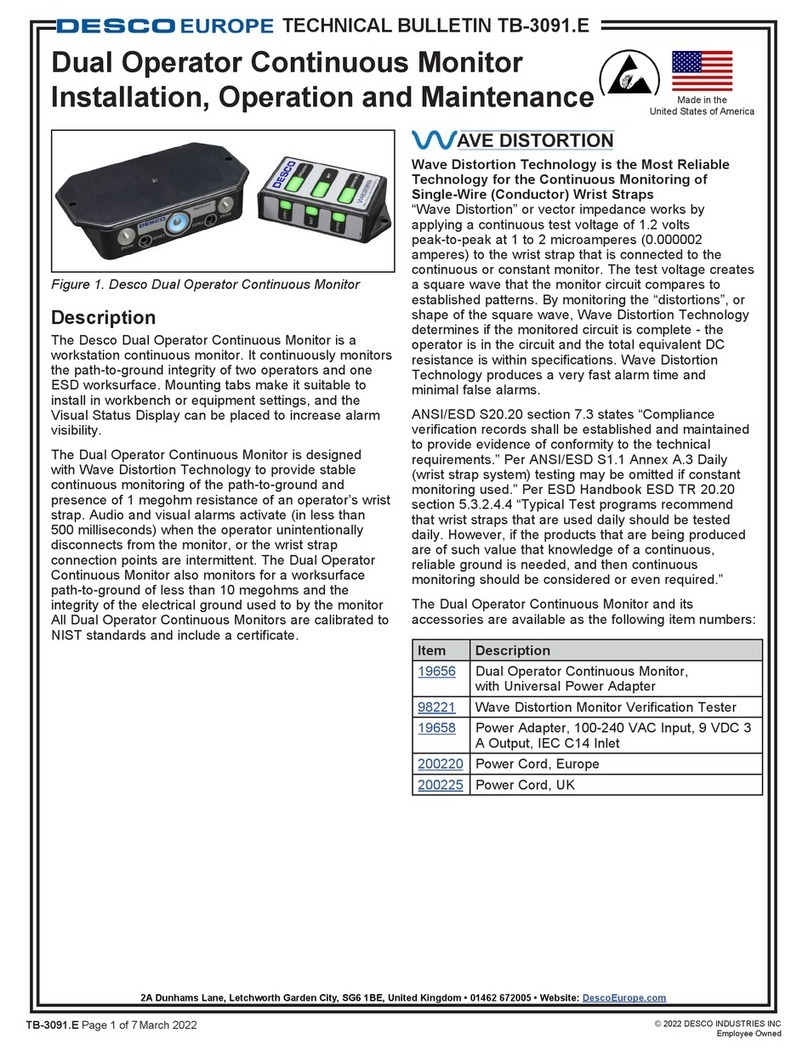
Desco
Desco 19656 Installation, operation and maintenance instructions
AlkoHAWK
AlkoHAWK AlkoHAWK Beacon owner's manual

Magneti Marelli
Magneti Marelli iBat Expert Pro owner's manual
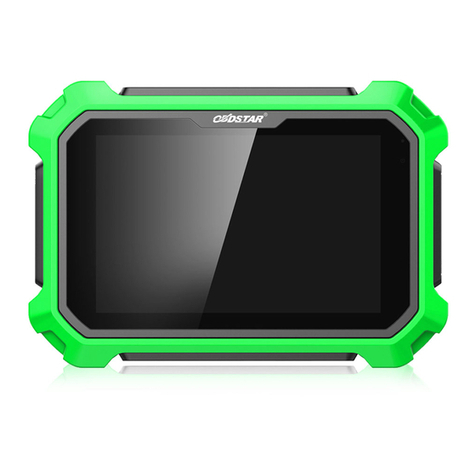
Obdstar
Obdstar Key Master DP Plus user manual
